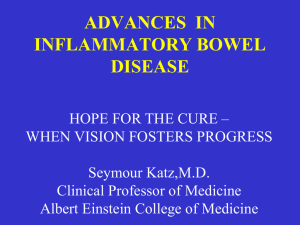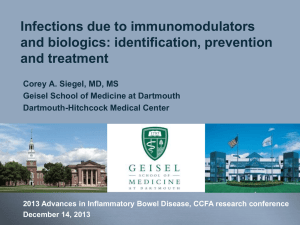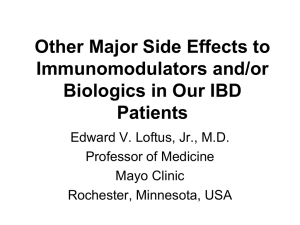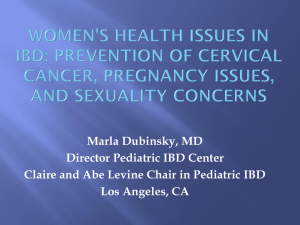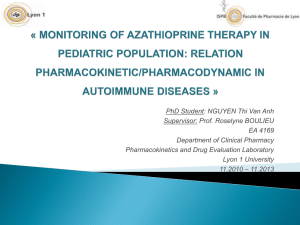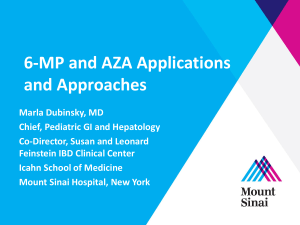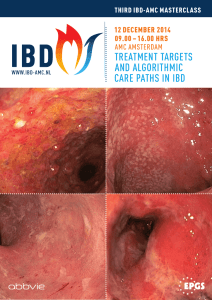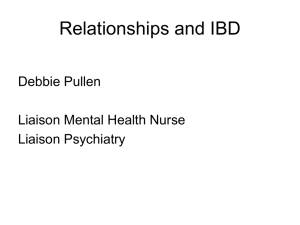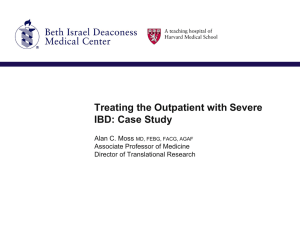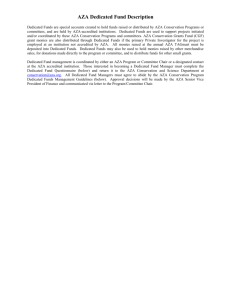Pro: Immunomodulators and Anti-TNFs Must Be Stopped When a
advertisement
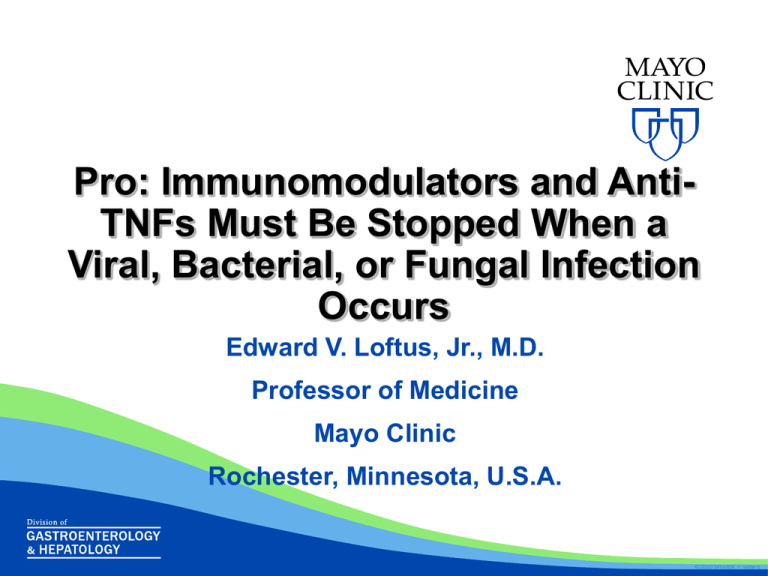
Pro: Immunomodulators and AntiTNFs Must Be Stopped When a Viral, Bacterial, or Fungal Infection Occurs Edward V. Loftus, Jr., M.D. Professor of Medicine Mayo Clinic Rochester, Minnesota, U.S.A. ©2010 MFMER | slide-1 Loftus Disclosures (last 12 months) • Research support • • • • • • • • • • • • • AbbVie UCB Bristol-Myers Squibb Shire Genentech Janssen Amgen Pfizer Braintree Takeda GlaxoSmithKline Robarts Clinical Trials Santarus • Consultant •AbbVie •UCB •Janssen •Takeda •Immune Pharmaceuticals Case: 26 Year Old Man with Ulcerative Colitis • Diagnosed with proctitis 3 years ago • Severe flare 1 year ago: now with extensive disease • Steroid-dependent • Azathioprine 2.5 mg/kg body weight daily • Still steroid-dependent after 3 months • CXR, PPD negative • Infliximab 5 mg/kg started, 3-dose induction and scheduled maintenance • Visit at 8 weeks: significant clinical improvement Case: Steroid-Dependent UC • Week 10: calls to report 10 days of fever, myalgia, chest discomfort, dry cough • Seen urgently that day • CXR: “negative” • Chest CT: numerous tiny nodules throughout lungs, mediastinal lymphadenopathy • ID: consistent with a granulomatous infection such as histoplasmosis • Histoplasma serology negative, no clinical response to itraconazole Case: Steroid-Dependent UC • Referred to pulmonary • Bronchoscopy, transbronchial biopsy/aspirate negative • Original induced sputum from 2 weeks ago grew out Mycobacterium tuberculosis • Prednisone and infliximab and AZA all held • Started on ethambutol, pyrazinamide, rifampin, isoniazid: 9 months • Developed arthralgias and fevers 2 weeks after starting antimycobacterial therapy • Eventually diagnosed as immune reconstitution syndrome • Restarted on low-dose prednisone • Serious flare of UC 1 year after TB • Hospitalized • Colectomy Infection Definitions • Opportunistic infection •Infection by an organism which has limited pathogenic capacity in ordinary circumstances • Serious infection •Infection resulting in need for intravenous therapy or hospitalization, or which results in disability or death • Not all opportunistic infections are serious and not all serious infections are opportunistic Immunosuppression in IBD • Not all IBD patients are immunosuppressed • Most important factors •Increased age •Malnutrition •Comorbidities (e.g., COPD, DM) •Medications: steroids, immunosuppressives, biologics •Hospitalization • Interplay of these factors results in variable amounts of immunosuppression with same medications • No clinical test available to measure “immunity” Mayo Case-Control Study (n = 100 Trios): Age Associated with Opportunistic Infection • Age at IBD diagnosis: •Odds Ratio (per 5 years), 1.1 (1.1-1.2) • Age at first Mayo visit: 0 – 23 •24 – 36 •37 – 49 • ≥ 50 • 1.0 (reference) 1.2 (0.5 – 2.8) 1.1 (0.5 – 2.5) 3.0 (1.2 – 7.2) Toruner M et al, Gastroenterology 2008; 134:929-36. Biologics in the Elderly Adverse Events Older Cohort (n=89) Younger Cohort (n=178) Events N Patients N (%) Events N Patients N (%) Adverse Event 61 40 (45) 67 41 (23) Serious Adverse Events 32 24 (27) 29 17 (10) Serious Infections 27 20 (22) 26 15 (8) Older age, HR unadjusted 1.9 (1.2 – 3.1) HR adjusted 1.7 (1.1 – 2.8) Bhushan A et al, DDW Abstract 2010 Mayo Case-Control Study (n = 100 Trios): Immunosuppressive Medications Were Associated with Increased Risk of Opportunistic Infections Odds Ratio (95% CI) P value Any Medication (5-ASA, AZA/6-MP, steroids, MTX, infliximab) 3.5 (2 - 6.1) <0.0001* 5-ASA 1.0 (0.6 - 1.6) 0.94 Corticosteroids 3.4 (1.8 - 6.2) <0.0001* 6-MP/azathioprine 3.1 (1.7 - 5.5) 0.0001* Methotrexate 4.0 (0.4 - 44.1) 0.26 Infliximab 4.4 (1.2 - 17.1) 0.03 Toruner M et al, Gastroenterology 2008; 134:929-36. Risk Factors for Opportunistic Infections in IBD: A Case-Control Study Odds Ratio (95% CI) P value 1 medication 2.65 (1.45-4.82) 0.0014 ≥2 medications 14.5 (4.9-43) <0.0001 Toruner M et al, Gastroenterology 2008; 134:929-36. Infections and Mortality in the TREAT Registry: 15,000 Patient-Years of Experience Multivariate analysis 4.5 Mortality 4.0 Serious infections Odds ratio 3.5 3.0 2.5 2.0 1.5 1.0 IFX AZA 6-MP MTX * IFX Steroids AZA 6-MP MTX ** Steroids 0.5 0.0 *P=0.001 **P<0.0001 IFX = infliximab; AZA = azathioprine; MTX = methotrexate Lichenstein GR et al, Gastroenterology 2006;130(Suppl 4):A-71. Lichtenstein GR et al, Clin Gastroenterol Hepatol 2006;4:621-30. Infliximab Dose and Serious Infection: RCT in RA (n = 1084) • RCT of placebo vs 2 doses of infliximab in RA • Relaxed entry criteria to allow co-morbidities • Group 1: placebo to wk 22, then 3 mg/kg q 8 • Group 2: 3 mg/kg to wk 22, then escalate by 1.5 mg/kg PRN • Group 3: 10 mg/kg throughout • Primary endpoint: risk of serious infection at week 22 4.5 Group 1 Group 2 Group 3 4 3.5 P = 0.013 3 2.5 2 1.5 1 0.5 0 Relative Risk Serious Infection Westhovens R et al. Arthritis Rheum. 2006;54:1075-86 # TB Cases Week 54 Risk of Hospitalization for Serious Infection After Starting Medication for IBD (n=2,323 Pairs Matched on Propensity Score) • Incidence rates: • Anti-TNF: 10.9 per 100 PY • AZA/6MP: 9.6 per 100 PY • Adjusted hazard ratio: 1.1 (0.8-1.5) Grijalva CG et al, JAMA 2011 Online Early AZA Increases the Incidence of Certain Viral Infections Prospective study (n=230) NS * 20 18 NS 16 2.0 * 1.5 Patients (%) Infection/patient-year 14 1.0 12 10 8 6 4 0.5 2 0 0 AZA+ n=169 AZA– n=61 Upper respiratory tract infections AZA+ n=169 AZA– n=61 Herpes virus flare-ups AZA+ AZA– Warts at the entry in the study AZA+ Appearance of increased number of warts Seksik P et al. Aliment Pharmacol Ther 2009;29:1106-13. NS = not significant AZA– Cervical Dysplasia in IBD • Some (not all) studies suggest that cervical dypslasia is more common in women with IBD • Presumably mediated through HPV reactivation • Immunosuppressive medications • Cigarette smoking • Recommend annual screening for cervical dysplasia in women with IBD, especially those who smoke and are on immunosuppressives Bhatia J et al, World J Gastroenterol 2006;12:6167-71. Kane S et al, Am J Gastroenterol 2008;103:631-6. Singh H et al, Gastroenterology 2009;136:451-8. Lees CW et al, Inflamm Bowel Dis 2009;15:1621-9. ECCO Guidelines for Managing Opportunistic Viral Infections Virus Screen? Vaccinate? Withdraw? HCV Not necessary N/A No HBV Yes Yes No but treat preemptive HIV Consider testing N/A No if counts OK CMV No N/A Yes HSV No N/A Only for severe VZV Yes if no hx Yes Only for severe EBV No N/A Only for severe HPV Cervical ca Yes Only for severe JCV Yes N/A Yes Rahier JF et al, J Crohns Colitis 2009;3:47-91 ©2010 MFMER | slide-17 Clostridium difficile Infection and IBD Increasing percentage of C. diff infections are IBD patients Increasing number of hospitalizations in IBD patients with C. diff •Classic risk factors disappearing •Pseudomembranes usually not present •Low threshold for checking in IBD patients with flares •Should you stop immunosuppression? Conflicting data Issa M, et al. Clin Gastroenterol Hepatol 2007; 5: 345-51. Granulomatous Infections After TNF Blockade • Bacterial •Tuberculosis •Atypical mycobacterial infection •Listeriosis • Invasive fungal •Histoplasmosis •Coccidioidomycosis •Candidiasis •Aspergillosis •Pneumocystosis •Others Lee JH et al. Arthritis Rheum. 2002;46:2565-70 Velayos FS et al. Inflamm Bowel Dis. 2004;10:657-60 Bergstrom L et al. Arthritis Rheum. 2004;50:1959-66 Geographic Distribution of Histoplasmosis and Coccidioidomycosis in Older Americans, 1999-2008: Medicare Sample Histoplasmosis Coccidiodomycosis Cases per 100,000 person-years Baddley JW et al, Emerging Infect Dis 2011;17:1664-9. Fungal Infections and Anti-TNF Therapy: MEDLINE and PubMed Until 2007 Tsiodras S et al, Mayo Clin Proc 2008;83:181-94. Long-Term Outcome of Patients Treated With IV Cyclosporine for Severe UC (n=86) • Aspergillus pneumonia 60 yr old man, IV Steroids, AZA, cyclosporine • Aspergillus pneumonia 57 yr old man, IV Steroids, cyclosporine, surgery • Pneumocystis jiroveci 32 yr old man, Steroids, cyclosporine, AZA Arts J et al. Inflamm Bowel Dis 2004;10:73-8. Tuberculosis Screening • Average risk: tuberculin test and chest Xray • Residents of endemic areas and/or those who received BCG •Interferon gamma release assay (QuantiFERON) • Latent infection: INH for 6-9 months, can start anti-TNF after 3 weeks • Active infection: do not start or reinitiate anti-TNF until a minimum of 2 months of anti-TB therapy ECCO Guidelines for Managing Fungal Infections, Bacterial Infections and Tuberculosis Organism Screen? Vaccinate? Withdraw? Fungal No N/A Individualize TB Yes N/A Latent: wait 3 weeks Active: yes wait 2 months Screen at flare N/A Individualize No N/A Individualize C diff Various bacterial Rahier JF et al, J Crohns Colitis 2009;3:47-91 ©2010 MFMER | slide-24 Conclusions • Serious and opportunistic infections occur in IBD patients • Risk factors include older age, hospitalization, corticosteroids, immunosuppressives, anti-TNF agents • Overall risk of serious infection with anti-TNF probably no higher than with thiopurines • Pay close attention in the elderly • Stay vigilant • Weigh benefit to risk ratio in each patient • Decision to stop immunosuppression in most cases is individualized-get I.D. support
